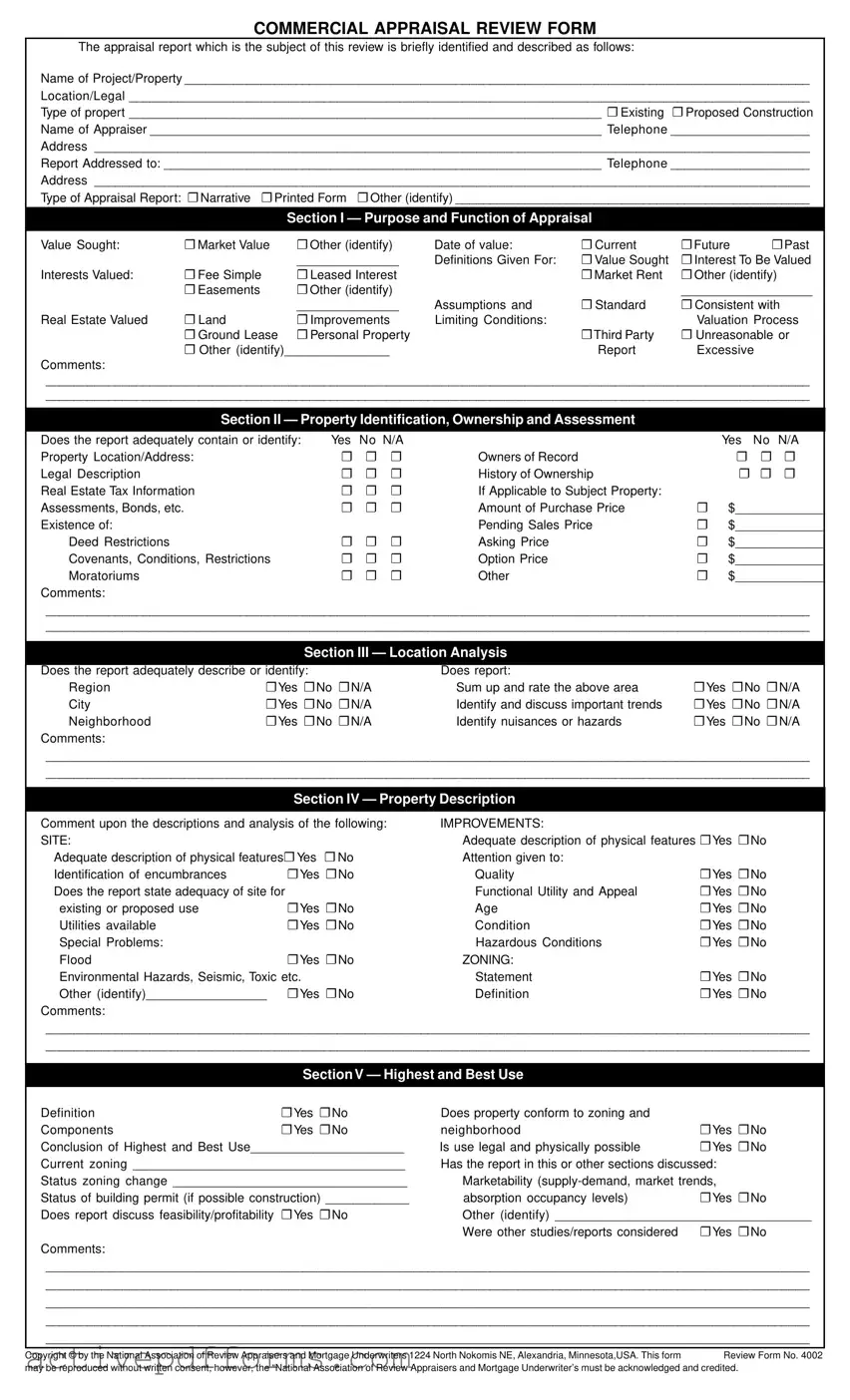COMMERCIAL APPRAISAL REVIEW FORM
The appraisal report which is the subject of this review is briefly identified and described as follows:
Name of Project/Property __________________________________________________________________________________________
Location/Legal __________________________________________________________________________________________________
Type of propert ____________________________________________________________________ ❐ Existing ❐ Proposed Construction
Name of Appraiser _________________________________________________________________ Telephone ____________________
Address |
_______________________________________________________________________________________________________ |
Report Addressed to: _______________________________________________________________ Telephone ____________________ |
Address |
_______________________________________________________________________________________________________ |
Type of Appraisal Report: ❐ Narrative ❐ Printed Form ❐ Other (identify) ___________________________________________________ |
Section I — Purpose and Function of Appraisal
Value Sought: |
❐ Market Value |
❐ Other (identify) |
Date of value: |
❐ Current |
❐ Future |
❐ Past |
|
|
______________ |
Definitions Given For: |
❐ Value Sought |
❐ Interest To Be Valued |
Interests Valued: |
❐ Fee Simple |
❐ Leased Interest |
|
❐ Market Rent |
❐ Other (identify) |
|
❐ Easements |
❐ Other (identify) |
|
|
__________________ |
|
|
______________ |
Assumptions and |
❐ Standard |
❐ Consistent with |
Real Estate Valued |
❐ Land |
❐ Improvements |
Limiting Conditions: |
|
Valuation Process |
|
❐ Ground Lease |
❐ Personal Property |
|
❐ Third Party |
❐ Unreasonable or |
|
❐ Other (identify)_______________ |
|
Report |
Excessive |
|
Comments: |
|
|
|
|
|
|
______________________________________________________________________________________________________________
______________________________________________________________________________________________________________
Section II — Property Identification, Ownership and Assessment
Does the report adequately contain or identify: |
Yes |
No |
N/A |
|
|
Yes |
No N/A |
|
Property Location/Address: |
❐ |
❐ |
❐ |
Owners of Record |
|
❐ |
❐ |
❐ |
Legal Description |
❐ |
❐ |
❐ |
History of Ownership |
|
|
|
|
Real Estate Tax Information |
❐ |
❐ |
❐ |
If Applicable to Subject Property: |
|
|
|
|
Assessments, Bonds, etc. |
❐ |
❐ |
❐ |
Amount of Purchase Price |
❐ |
$____________ |
Existence of: |
|
|
|
Pending Sales Price |
❐ |
$____________ |
Deed Restrictions |
❐ |
❐ |
❐ |
Asking Price |
❐ |
$____________ |
Covenants, Conditions, Restrictions |
❐ |
❐ |
❐ |
Option Price |
❐ |
$____________ |
Moratoriums |
❐ |
❐ |
❐ |
Other |
❐ |
$____________ |
Comments: |
|
|
|
|
|
|
|
|
______________________________________________________________________________________________________________
______________________________________________________________________________________________________________
Section III — Location Analysis
Does the report adequately describe or identify: |
Does report: |
|
Region |
❐ Yes ❐ No ❐ N/A |
Sum up and rate the above area |
❐ Yes ❐ No ❐ N/A |
City |
❐ Yes ❐ No ❐ N/A |
Identify and discuss important trends |
❐ Yes ❐ No ❐ N/A |
Neighborhood |
❐ Yes ❐ No ❐ N/A |
Identify nuisances or hazards |
❐ Yes ❐ No ❐ N/A |
Comments: |
|
|
|
______________________________________________________________________________________________________________
______________________________________________________________________________________________________________
Section IV — Property Description
Comment upon the descriptions and analysis of the following: |
IMPROVEMENTS: |
|
SITE: |
|
Adequate description of physical features ❐ Yes ❐ No |
Adequate description of physical features❐ Yes ❐ No |
Attention given to: |
|
Identification of encumbrances |
❐Yes ❐ No |
Quality |
❐ Yes ❐ No |
Does the report state adequacy of site for |
|
Functional Utility and Appeal |
❐ Yes ❐ No |
existing or proposed use |
❐Yes ❐ No |
Age |
❐ Yes ❐ No |
Utilities available |
❐Yes ❐ No |
Condition |
❐ Yes ❐ No |
Special Problems: |
|
Hazardous Conditions |
❐ Yes ❐ No |
Flood |
❐Yes ❐ No |
ZONING: |
|
Environmental Hazards, Seismic, Toxic etc. |
Statement |
❐ Yes ❐ No |
Other (identify)_________________ |
❐Yes ❐ No |
Definition |
❐ Yes ❐ No |
Comments: |
|
|
|
______________________________________________________________________________________________________________
______________________________________________________________________________________________________________
Section V — Highest and Best Use
Definition |
❐ Yes ❐ No |
Does property conform to zoning and |
|
Components |
❐ Yes ❐ No |
neighborhood |
❐ Yes ❐ No |
Conclusion of Highest and Best Use______________________ |
Is use legal and physically possible |
❐ Yes ❐ No |
Current zoning ______________________________________ |
Has the report in this or other sections discussed: |
Status zoning change _________________________________ |
Marketability (supply-demand, market trends, |
Status of building permit (if possible construction) ____________ |
absorption occupancy levels) |
❐ Yes ❐ No |
Does report discuss feasibility/profitability |
❐ Yes ❐ No |
Other (identify) ____________________________________ |
|
|
Were other studies/reports considered |
❐ Yes ❐No |
Comments: |
|
|
|
______________________________________________________________________________________________________________
______________________________________________________________________________________________________________
______________________________________________________________________________________________________________
______________________________________________________________________________________________________________
______________________________________________________________________________________________________________


